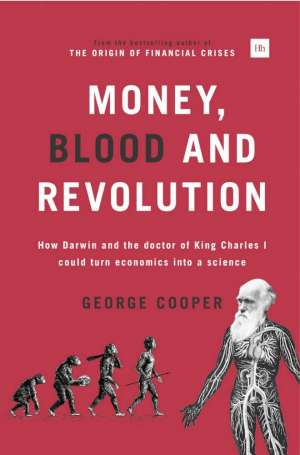31 March 2015
Money, blood and revolution
How Darwin and the doctor of King Charles I could turn economics into a science
George Cooper
2014, Harriman House, 204 pages, £18.99
Reviewer: Keith, Wade, Chief Economist, Schroders

Ever since the financial crisis started in 2007, economics has been on the back foot as an academic discipline with no less than Her Majesty the Queen asking why the profession failed to see the catastrophe coming. In this book, which is written for a broad audience, George Cooper argues that economics is in need of a revolution.
His starting point is Thomas Kuhn’s The Structure of Scientific Revolutions published in 1962, which argues that a discipline which is unable to explain current events and has many competing schools of thought is in need of a paradigm shift in thinking. This would certainly seem to fit economics today, with Keynesians and neo-classical economists and a host of others such as the Austrian and monetarist schools, all at odds on the origins of the crisis and what policy measures are now needed to take the world economy forward. Meanwhile, students protest that their courses do little to explain why economists failed to warn about the financial crisis.
Cooper begins by tracing how other disciplines have been through this very process, eloquently describing four scientific revolutions from the past. Astronomy was stuck for years with the belief that the earth was at the centre of the universe before Copernicus demonstrated that our planet revolved around the sun, itself only part of the wider universe. William Harvey, the King’s physician from the book’s title, transformed medicine with his theory of the circulation of the blood. Charles Darwin revolutionised our understanding of species with his theory of evolution and in geology Alfred Wegener resolved the major problems of the science with his concept of continental drift. Each scientist brought new ways of thinking which enabled their discipline to escape an intellectual lacuna and break new ground.
The author admits his choices are selective, but argues that they demonstrate how a science will build models based on a set of beliefs until the point at which they are no longer valid. This presents a massive hurdle to those working in the discipline who have little option but to continue with the existing paradigm until a better one comes along. External pressure can also come into play from individuals and institutions with a vested interest in the status quo and consequently the science will continue to adapt its existing beliefs rather than actively seek to strike out in a new direction. This helps explains why economics has yet to change: it is not that the industry has failed to recognise a problem (as demonstrated by new groups such as the Institute for New Economic Thinking), but without a new paradigm comes along economists will continue with pre-crisis models.
In the second part of the book there is an excellent survey of the current state of economics mapping the different schools of thought according to their belief in the stability of markets and the level of optimal government involvement in the economy. Business economists and policymakers will find this a useful refresher and framework for placing in context resurgent ideas such as those based on the work of Hyman Minsky.
Finally, the book concludes with an attempt to make the paradigm shift. Cooper seeks to make the leap with his “circulatory theory of economic growth”, based on a model where agents behave in a Darwinian fashion and compete against each other rather than seeking to maximise individual utility. He attributes economic growth to a combination of capitalism and democracy, whereby the former tends to push wealth up the social structure toward the wealthy, whilst the latter pushes it back down. This circulation of wealth then drives growth by directing funds to those who have the greatest incentive to improve their position in the social pyramid.
It is certainly a brave attempt and has the merit of challenging the assumption that individuals solely seek to maximise their utility today and into the future. This has to be a move in the right direction and judging from the resurgence of interest in behavioural economics, economists seem more open to different ways of understanding behaviour under uncertainty. Even Alan Greenspan, who championed neo-classical economics during his tenure as chairman of the US Federal Reserve, has admitted his error in assuming that allowing individuals to act in their own interest would deliver the best outcome for society.
Clearly there is far more work to be done, scientific revolutions can take decades, but perhaps we are at the start of the paradigm shift. Cooper makes the point that it is often the outsiders who make the breakthrough (he is a trained scientist), and that the resistance comes from those in the profession. For that reason alone, professional economists need to read this book. More generally I would recommend it as it moves the debate on from who to blame for the financial crisis by turning the spotlight on the ‘science’ of economics itself.
